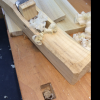Hey Folks,
First, my apologies if this has been discussed, but I had no luck with this specific situation after an hour of searching.
I have an IR 3HP, 220 volt, (running HP) compressor (motor plate says 15A) that I need to get power to. The motor has its own thermal overload protection. I realize that I could just run another 20A circuit, but we're looking at a lot of wire, drilling holes through I-joists that are not too easy to access, etc.
_However_, I do have an outlet for the welder (which I rarely use) about 3 feet from the compressor's location. It has the dryer type receptacle, and is a 50 amp breaker with #6 copper from the subpanel. What I'd like to do is use a short length of #10 rubber coated wire, get another dryer plug, and just plug the compressor in to the dryer outlet.
Am I violating any major principles here? I realize #10 wire is not the proper size for a 50 amp breaker, but also the 18 gauge wire on the lamp on my living room end table is not the proper size for the 20 amp breaker on the circuit that it's plugged into at the wall receptacle.
Thanks in advance for your expert opinions.
JS




 Reply With Quote
Reply With Quote






